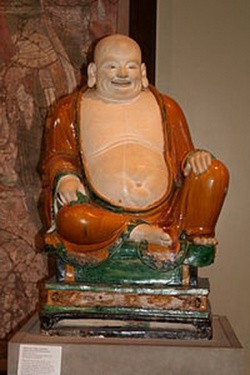Difference between revisions of "Chan/Zen School (Chanzong 禪宗)"
| Line 1: | Line 1: | ||
[[File:20 fdgf.JPG|thumb|250px|]] | [[File:20 fdgf.JPG|thumb|250px|]] | ||
| − | |||
| − | Because of the [[Emptiness]] (Sanskr. [[śūnyatā]]; Chin. [[kong]] [[空]]) of [[reality]], the [[Buddha nature]] can only be apprehended by {{Wiki|intuition}}. Avoiding [[conscious]] [[Thought]], [[reality]] is expressed by [[silence]] or {{Wiki|negation}} of the [[object]] in [[Mind]]. It was the [[Chan School]] that also developed the worldwide known fighting techniques ([[gongfu]] [[功夫]], "[[Kung-fu]]") in the [[Shaolin Monastery]] [[少林寺]]. The spontaneity [[Thought]] of [[Chan Buddhism]] is familiar to {{Wiki|Taoism}} and the nature-near spontaneous [[action]] of the free {{Wiki|individual}}. [[Chan]] [[Monks]] also composed writings like the "[[Green Cliff Records]]" [[Biyan Lu]] [[碧巖録]], and the "[[Gateless Pass]]" [[Wumenguan]] [[無門關]]. | + | |
| + | |||
| + | |||
| + | |||
| + | |||
| + | |||
| + | |||
| + | A very special school that renounced {{Wiki|dogma}}, {{Wiki|asceticism}}, [[rites]] and the [[traditional]] [[Monastery]] system, even sometimes to an iconoclastic extent (refusing or even destroying images of The [[Buddha]] and [[bodhisattvas]]), was the [[Chan School]] [[禪宗]] ([[Chanzong]], Jap. [[Zen shū]], Kor. [[Jŏn jong]]; a term deriving from the [[Sanskrit]] [[word]] [[Dhyāna]] "[[Meditation]], | ||
| + | |||
| + | [[yoga]]"), founded by [[Bodhidharma]] ([[Putidamo]] [[菩提達摩]]; d. 524) and [[Huineng]] [[慧能]] (d. 713; see an excerpt from his [[Writing]] [[Tanjing]] [[壇經]] "[[Platform Sutra]]" or "[[Altar Sutra]]"). The believers of [[Chan]] relied on riddles ([[gongan]] [[公案]]) and spontaneous [[actions]] to achieve [[Enlightenment]]. | ||
| + | |||
| + | |||
| + | Because of the [[Emptiness]] ([[Sanskr]]. [[śūnyatā]]; [[Chin]]. [[kong]] [[空]]) of [[reality]], the [[Buddha nature]] can only be apprehended by {{Wiki|intuition}}. Avoiding [[conscious]] [[Thought]], [[reality]] is expressed by [[silence]] or {{Wiki|negation}} of the [[object]] in [[Mind]]. It was the [[Chan School]] that also developed the worldwide known fighting [[techniques]] ([[gongfu]] [[功夫]], "[[Kung-fu]]") in the | ||
| + | |||
| + | [[Shaolin Monastery]] [[少林寺]]. The spontaneity [[Thought]] of [[Chan Buddhism]] is familiar to {{Wiki|Taoism}} and the nature-near spontaneous [[action]] of the free {{Wiki|individual}}. [[Chan]] [[Monks]] also composed writings like the "[[Green Cliff Records]]" [[Biyan Lu]] [[碧巖録]], and the "[[Gateless Pass]]" [[Wumenguan]] [[無門關]]. | ||
| + | |||
| + | |||
Important branches of the [[Chan]] School are the [[Caodong School]] [[曹洞宗]] and the [[Linji School]] [[臨濟宗]]. | Important branches of the [[Chan]] School are the [[Caodong School]] [[曹洞宗]] and the [[Linji School]] [[臨濟宗]]. | ||
| + | |||
{{R}} | {{R}} | ||
[http://www.chinaknowledge.de/Literature/Religion/buddhist-schools.html www.chinaknowledge.de] | [http://www.chinaknowledge.de/Literature/Religion/buddhist-schools.html www.chinaknowledge.de] | ||
Latest revision as of 10:45, 26 December 2023
A very special school that renounced dogma, asceticism, rites and the traditional Monastery system, even sometimes to an iconoclastic extent (refusing or even destroying images of The Buddha and bodhisattvas), was the Chan School 禪宗 (Chanzong, Jap. Zen shū, Kor. Jŏn jong; a term deriving from the Sanskrit word Dhyāna "Meditation,
yoga"), founded by Bodhidharma (Putidamo 菩提達摩; d. 524) and Huineng 慧能 (d. 713; see an excerpt from his Writing Tanjing 壇經 "Platform Sutra" or "Altar Sutra"). The believers of Chan relied on riddles (gongan 公案) and spontaneous actions to achieve Enlightenment.
Because of the Emptiness (Sanskr. śūnyatā; Chin. kong 空) of reality, the Buddha nature can only be apprehended by intuition. Avoiding conscious Thought, reality is expressed by silence or negation of the object in Mind. It was the Chan School that also developed the worldwide known fighting techniques (gongfu 功夫, "Kung-fu") in the
Shaolin Monastery 少林寺. The spontaneity Thought of Chan Buddhism is familiar to Taoism and the nature-near spontaneous action of the free individual. Chan Monks also composed writings like the "Green Cliff Records" Biyan Lu 碧巖録, and the "Gateless Pass" Wumenguan 無門關.
Important branches of the Chan School are the Caodong School 曹洞宗 and the Linji School 臨濟宗.
